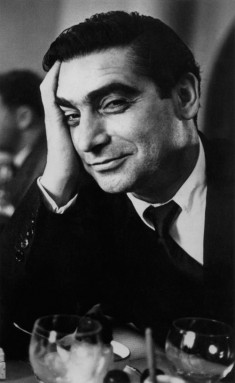| Robert Capa | |
|---|---|
 |
|
| Photographer | |
| Born | Oct. 22, 1913 Budapest, Austria-Hungary |
| Died | May 25, 1954 (at age 40) Thai Binh, State of Vietnam |
| Nationality | Hungarian |
Robert Capa was a photographer and photojournalist of Jewish descent. He is best known for photographing and documenting parts of WW2 in North Africa, England, and Italy. His photos, like those captured during the Spanish Civil War and the 1944 Normandy assault, portray the violence of conflict with a distinctive impact.
Early Life
Robert Capa was born in 1913 in Budapest to Jewish parents. Like most of his student colleagues, he was actively involved in the political uproar of the time. At age 18, he was arrested due to his political activities. He was then released through his father’s intervention but was banished from Hungary. He relocated to Germany in 1931 where he studied political science at the Deutsche Hochschule für Politik.
Capa’s Career Years
While in Berlin, Capa worked as a darkroom assistant at Dephot, one of the leading photo-journalist enterprises in Germany. The agency was popular for its use of advanced cameras as well as fast film that enabled photographers to take images even in darkness.
With such advances, the photographer could concentrate on human events and back off from diplomats’ rows that characterized news photography. Robert was able to master the cameras and the agency gave him small photographic assignments. His first assignment was in Copenhagen. He was sent there to photography Leon Trotsky.
With Hitler’s rise in 1933, Robert eventually relocated to Paris. He found it hard to find work in France as a freelance journalist because he was from Hungary. It is around this time that he adopted the name “Robert Capa” as he felt that the name was American-sounding because it resembled that of Frank Capra, a renowned film director.
A Dangerous Career Ensues
In 1936, Capa went to Spain to with his friend, Taro, to photograph the horrors of the Civil War that was occurring there. His image of a soldier who had been badly wounded made Capa popular. In 1937, Taro was murdered by a tank in Spain. She was only 26 years of age.
 After his companion was killed in Spain, he went to China and immigrated to the U.S. one year later. At the commencement of the WW2, Capa was in New York. The war took him to different parts of European theatres on photography assignments. First he worked for Collier’s Weekly before he switched to Life in 1943.
After his companion was killed in Spain, he went to China and immigrated to the U.S. one year later. At the commencement of the WW2, Capa was in New York. The war took him to different parts of European theatres on photography assignments. First he worked for Collier’s Weekly before he switched to Life in 1943.
His most renowned work occurred in 1944 when he swam ashore the Omaha Beach. He captured over 100 pictures in the first few hours of the assault. Nonetheless, a staff member at Life accidentally melted the emulsion in the film. Only 11 frames were recovered, but they became iconic photos from D-Day and the series of photographs were entitled The Magnificent Eleven.
In 1947, Robert went to the Soviet Union. He took photographs in Moscow, Tbilisi, Kiev, and Batumi. In the same year, Robert, together with William Vandivert, Henri Cartier-Bresson, David Seymour, and George Rodger, he co-founded Magnum Photos. In 1950, Robert was recalled by Life to replace one photographer on an assignment in Indochina. He accepted the assignment and was murdered after he stepped on a landmine while photographing for the magazine.
He died on May 25, 1954, at the age of 40.